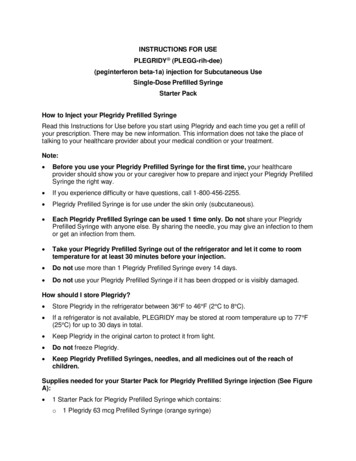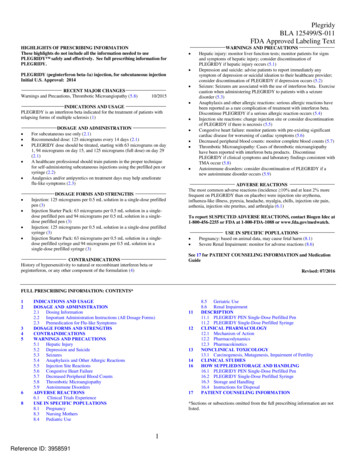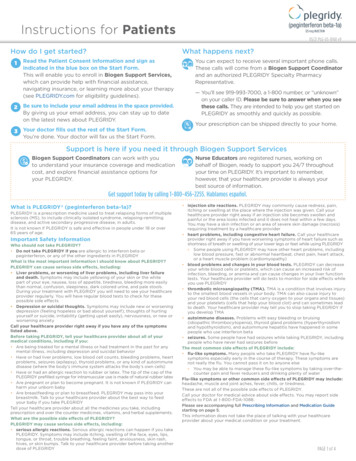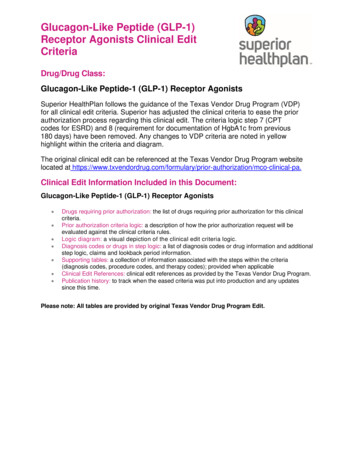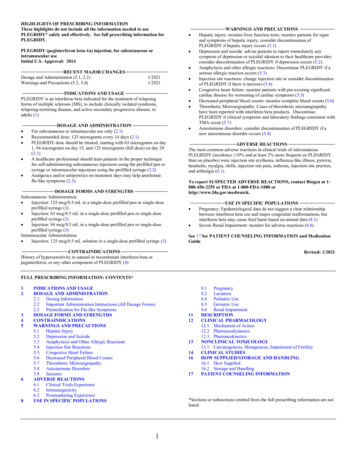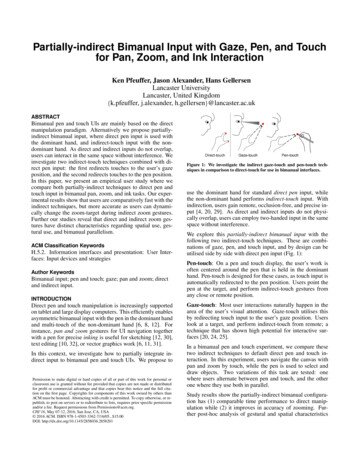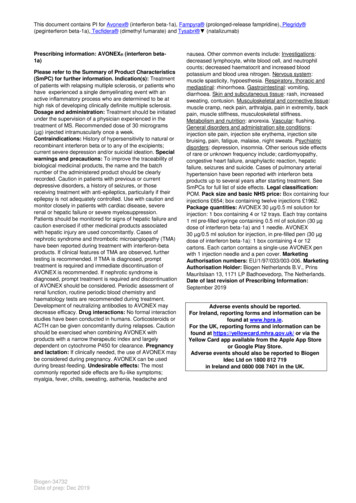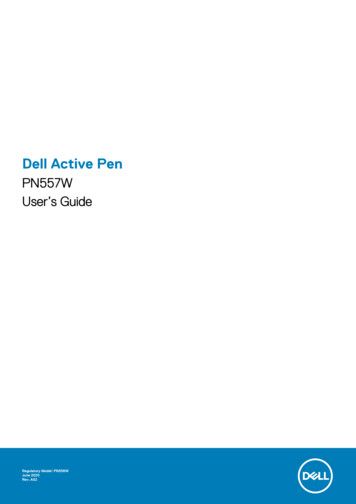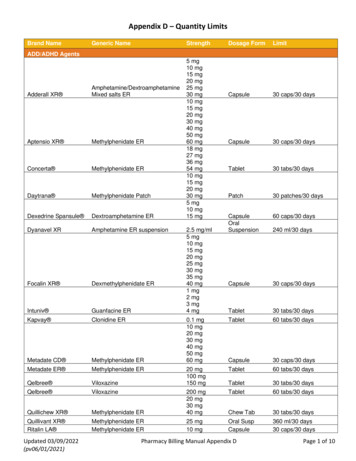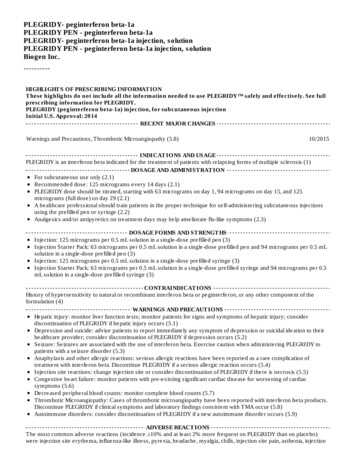
Transcription
PLEGRIDY- peginterferon beta-1aPLEGRIDY PEN - peginterferon beta-1aPLEGRIDY- peginterferon beta-1a injection, s olutionPLEGRIDY PEN - peginterferon beta-1a injection, s olutionBiogen Inc.---------HIGHLIGHT S OF PRESCRIBING INFORMAT IONT hese hig hlig hts do no t include all the info rmatio n needed to use PLEGRIDY safely and effectively. See fullprescribing info rmatio n fo r PLEGRIDY.PLEGRIDY (peg interfero n beta-1a) injectio n, fo r subcutaneo us injectio nInitial U.S. Appro val: 20 14RECENT MAJOR CHANGESWarnings and Precautions, Thrombotic Microangiopathy (5.8)10/2015INDICAT IONS AND USAGEPLEGRIDY is an interferon beta indicated for the treatment of patients with relapsing forms of multiple sclerosis (1)DOSAGE AND ADMINIST RAT IONFor subcutaneous use only (2.1)Recommended dose: 125 micrograms every 14 days (2.1)PLEGRIDY dose should be titrated, starting with 63 micrograms on day 1, 94 micrograms on day 15, and 125micrograms (full dose) on day 29 (2.1)A healthcare professional should train patients in the proper technique for self-administering subcutaneous injectionsusing the prefilled pen or syringe (2.2)Analgesics and/or antipyretics on treatment days may help ameliorate flu-like symptoms (2.3)DOSAGE FORMS AND ST RENGT HSInjection: 125 micrograms per 0.5 mL solution in a single-dose prefilled pen (3)Injection Starter Pack: 63 micrograms per 0.5 mL solution in a single-dose prefilled pen and 94 micrograms per 0.5 mLsolution in a single-dose prefilled pen (3)Injection: 125 micrograms per 0.5 mL solution in a single-dose prefilled syringe (3)Injection Starter Pack: 63 micrograms per 0.5 mL solution in a single-dose prefilled syringe and 94 micrograms per 0.5mL solution in a single-dose prefilled syringe (3)CONT RAINDICAT IONSHistory of hypersensitivity to natural or recombinant interferon beta or peginterferon, or any other component of theformulation (4)WARNINGS AND PRECAUT IONSHepatic injury: monitor liver function tests; monitor patients for signs and symptoms of hepatic injury; considerdiscontinuation of PLEGRIDY if hepatic injury occurs (5.1)Depression and suicide: advise patients to report immediately any symptom of depression or suicidal ideation to theirhealthcare provider; consider discontinuation of PLEGRIDY if depression occurs (5.2)Seizure: Seizures are associated with the use of interferon beta. Exercise caution when administering PLEGRIDY topatients with a seizure disorder (5.3)Anaphylaxis and other allergic reactions: serious allergic reactions have been reported as a rare complication oftreatment with interferon beta. Discontinue PLEGRIDY if a serious allergic reaction occurs (5.4)Injection site reactions: change injection site or consider discontinuation of PLEGRIDY if there is necrosis (5.5)Congestive heart failure: monitor patients with pre-existing significant cardiac disease for worsening of cardiacsymptoms (5.6)Decreased peripheral blood counts: monitor complete blood counts (5.7)Thrombotic Microangiopathy: Cases of thrombotic microangiopathy have been reported with interferon beta products.Discontinue PLEGRIDY if clinical symptoms and laboratory findings consistent with TMA occur (5.8)Autoimmune disorders: consider discontinuation of PLEGRIDY if a new autoimmune disorder occurs (5.9)ADVERSE REACT IONSThe most common adverse reactions (incidence 10% and at least 2% more frequent on PLEGRIDY than on placebo)were injection site erythema, influenza-like illness, pyrexia, headache, myalgia, chills, injection site pain, asthenia, injection
site pruritus, and arthralgia (6.1)T o repo rt SUSPECT ED ADVERSE REACT IONS, co ntact Bio g en at 1-8 0 0 -4 56 -2255 o r FDA at 1-8 0 0 -FDA-10 8 8o r www.fda.g o v/medwatch.USE IN SPECIFIC POPULAT IONSPregnancy: based on animal data, may cause fetal harm (8.1)Severe Renal Impairment: monitor for adverse reactions (8.6)See 17 fo r PAT IENT COUNSELING INFORMAT ION and Medicatio n Guide.Revised: 7/20 16FULL PRESCRIBING INFORMATION: CONTENTS*1 INDICATIONS AND USAGE2 DOSAGE AND ADMINISTRATION2.1 Dosing Information2.2 Important Administration Instructions (All Dosage Forms)2.3 Premedication for Flu-like Symptoms3 DOSAGE FORMS AND STRENGTHS4 CONTRAINDICATIONS5 WARNINGS AND PRECAUTIONS5.1 Hepatic Injury5.2 Depression and Suicide5.3 Seizures5.4 Anaphylaxis and Other Allergic Reactions5.5 Injection Site Reactions5.6 Congestive Heart Failure5.7 Decreased Peripheral Blood Counts5.8 Thrombotic Microangiopathy5.9 Autoimmune Disorders6 ADVERSE REACTIONS6.1 Clinical Trials Experience8 USE IN SPECIFIC POPULATIONS8.1 Pregnancy8.3 Nursing Mothers8.4 Pediatric Use8.5 Geriatric Use8.6 Renal Impairment11 DESCRIPTION11.1 PLEGRIDY PEN Single-Dose Prefilled Pen11.2 PLEGRIDY Single-Dose Prefilled Syringe12 CLINICAL PHARMACOLOGY12.1 Mechanism of Action12.2 Pharmacodynamics12.3 Pharmacokinetics13 NONCLINICAL TOXICOLOGY13.1 Carcinogenesis, Mutagenesis, Impairment of Fertility14 CLINICAL STUDIES16 HOW SUPPLIED/STORAGE AND HANDLING16.1 PLEGRIDY PEN Single-Dose Prefilled Pen16.2 PLEGRIDY Single-Dose Prefilled Syringe16.3 Storage and Handling16.4 Instructions for Disposal
17 PATIENT COUNSELING INFORMATION* Sections or subsections omitted from the full prescribing information are not listed.FULL PRESCRIBING INFORMATION1 INDICATIONS AND USAGEPLEGRIDY (peginterferon beta-1a) is indicated for the treatment of patients with relapsing forms ofmultiple sclerosis.2 DOSAGE AND ADMINISTRATION2.1 Dos ing InformationPLEGRIDY is administered subcutaneously.The recommended dosage of PLEGRIDY is 125 micrograms injected subcutaneously every 14 days.Treatment initiationPatients should start treatment with 63 micrograms on day 1. On day 15 (14 days later), the dose isincreased to 94 micrograms, reaching the full dose of 125 micrograms on day 29 (after another 14days). Patients continue with the full dose (125 micrograms) every 14 days thereafter (see Table 1). APLEGRIDY Starter Pack is available containing two prefilled pens or syringes: 63 micrograms (dose 1)and 94 micrograms (dose 2).Table 1: Schedule for Dos e TitrationDos eTime*Amount (micrograms )Dose 1Dose 2Dose 3On day 1On day 15On day 29 and every 14days thereafter6394125 (full dose)Color of Pen orSyringe LabelOrangeBlueGrey*Dosed every 14 days2.2 Important Adminis tration Ins tructions (All Dos age Forms )Healthcare professionals should train patients in the proper technique for self-administeringsubcutaneous injections using the prefilled pen or syringe. Patients should be advised to rotate sites forsubcutaneous injections. The usual sites for subcutaneous injections are abdomen, back of the upperarm, and thigh.Each PLEGRIDY pen and syringe is provided with the needle pre-attached. Prefilled pens and syringesare for a single dose only and should be discarded after use.2.3 Premedication for Flu-like SymptomsProphylactic and concurrent use of analgesics and/or antipyretics may prevent or ameliorate flu-likesymptoms sometimes experienced during treatment with PLEGRIDY.3 DOSAGE FORMS AND STRENGTHS
PenInjection: 125 micrograms of PLEGRIDY per 0.5 mL of solution in a single-dose prefilled penInjection: Starter Pack containing 63 micrograms per 0.5 mL of solution in a single-dose prefilledpen and 94 micrograms per 0.5 mL solution in a single-dose prefilled penPrefilled SyringeInjection: 125 micrograms of PLEGRIDY per 0.5 mL of solution in a single-dose prefilled syringeInjection: Starter Pack containing 63 micrograms per 0.5 mL of solution in a single-dose prefilledsyringe and 94 micrograms per 0.5 mL of solution in a single-dose prefilled syringe4 CONTRAINDICATIONSPLEGRIDY is contraindicated in patients with a history of hypersensitivity to natural or recombinantinterferon beta or peginterferon, or any other component of the formulation [see Warnings andPrecautions (5.4)].5 WARNINGS AND PRECAUTIONS5.1 Hepatic InjurySevere hepatic injury, including hepatitis, autoimmune hepatitis, and rare cases of severe hepaticfailure, have been reported with interferon beta. Asymptomatic elevation of hepatic transaminases hasalso been reported, and in some patients has recurred upon rechallenge with interferon beta.Elevations in hepatic enzymes and hepatic injury have been observed with the use of PLEGRIDY inclinical studies. The incidence of increases in hepatic transaminases was greater in patients takingPLEGRIDY than in those taking placebo. The incidence of elevations of alanine aminotransferase above5 times the upper limit of normal was 1% in placebo-treated patients and 2% in PLEGRIDY-treatedpatients. The incidence of elevations of aspartate aminotransferase above 5 times the upper limit ofnormal was less than 1% in placebo-treated patients and less than 1% in PLEGRIDY-treated patients.Elevations of serum hepatic transaminases combined with elevated bilirubin occurred in 2 patients. Bothcases resolved following discontinuation of PLEGRIDY.Monitor patients for signs and symptoms of hepatic injury.5.2 Depres s ion and SuicideDepression, suicidal ideation, and suicide occur more frequently in patients receiving interferon betathan in patients receiving placebo.In clinical studies, the overall incidence of adverse events related to depression and suicidal ideation inmultiple sclerosis patients was 8% in both the PLEGRIDY and placebo groups. The incidence ofserious events related to depression and suicidal ideation was similar and less than 1% in both groups.Advise patients to report immediately any symptom of depression or suicidal ideation to their healthcareprovider. If a patient develops depression or other severe psychiatric symptoms, consider stoppingtreatment with PLEGRIDY.5.3 SeizuresSeizures are associated with the use of interferon beta.The incidence of seizures in multiple sclerosis clinical studies was less than 1% in patients receivingPLEGRIDY and placebo.Exercise caution when administering PLEGRIDY to patients with a seizure disorder.5.4 Anaphylaxis and Other Allergic Reactions
Anaphylaxis and other serious allergic reactions are rare complications of treatment with interferonbeta.Less than 1% of PLEGRIDY-treated patients experienced a serious allergic reaction such asangioedema or urticaria. Those who did have serious allergic reactions recovered promptly aftertreatment with antihistamines or corticosteroids.Discontinue PLEGRIDY if a serious allergic reaction occurs.5.5 Injection Site ReactionsInjection site reactions, including injection site necrosis, can occur with the use of subcutaneousinterferon beta.In clinical studies, the incidence of injection site reactions (e.g., injection site erythema, pain, pruritus,or edema) was 66% in the PLEGRIDY group and 11% in the placebo group; the incidence of severeinjection site reactions was 3% in the PLEGRIDY group and 0% in the placebo group. One patient outof 1468 patients who received PLEGRIDY in clinical studies experienced injection site necrosis. Theinjury resolved with standard medical treatment.Decisions to discontinue therapy following necrosis at a single injection site should be based on theextent of the necrosis. For patients who continue therapy with PLEGRIDY after injection site necrosishas occurred, avoid administration of PLEGRIDY near the affected area until it is fully healed. Ifmultiple lesions occur, discontinue PLEGRIDY until healing occurs.5.6 Conges tive Heart FailureCongestive heart failure, cardiomyopathy, and cardiomyopathy with congestive heart failure occur inpatients receiving interferon beta.In clinical studies, the incidence of cardiovascular events was 7% in both PLEGRIDY and placebotreatment groups. No serious cardiovascular events were reported in the PLEGRIDY group.Monitor patients with significant cardiac disease for worsening of their cardiac condition duringinitiation and continuation of treatment with PLEGRIDY.5.7 Decreas ed Peripheral Blood CountsInterferon beta can cause decreased peripheral blood counts in all cell lines, including rare instances ofpancytopenia and severe thrombocytopenia.In clinical studies, decreases in white blood cell counts below 3.0 x 10 9 /L occurred in 7% of patientsreceiving PLEGRIDY and in 1% receiving placebo. There is no apparent association betweendecreases in white blood cell counts and an increased risk of infections or serious infections. Theincidence of clinically significant decreases in lymphocyte counts (below 0.5 x 10 9 /L), neutrophilcounts (below 1.0 x 10 9 /L), and platelet counts (below 100 x 10 9 /L) were all less than 1% and similar inboth placebo and PLEGRIDY groups. Two serious cases were reported in patients treated withPLEGRIDY: one patient (less than 1%) experienced severe thrombocytopenia (defined as a plateletcount less than or equal to 10 x 10 9 /L), and another patient (less than 1%) experienced severeneutropenia (defined as a neutrophil count less than or equal to 0.5 x 10 9 /L). In both patients, cell countsrecovered after discontinuation of PLEGRIDY. Compared to placebo, there were no significantdifferences in red blood cell counts in patients treated with PLEGRIDY.Monitor patients for infections, bleeding, and symptoms of anemia. Monitor complete blood cell counts,differential white blood cell counts, and platelet counts during treatment with PLEGRIDY. Patients withmyelosuppression may require more intensive monitoring of blood cell counts.5.8 Thrombotic MicroangiopathyCases of thrombotic microangiopathy (TMA), including thrombotic thrombocytopenic purpura and
hemolytic uremic syndrome, some fatal, have been reported with interferon beta products. Cases havebeen reported several weeks to years after starting interferon beta products. Discontinue PLEGRIDY ifclinical symptoms and laboratory findings consistent with TMA occur, and manage as clinicallyindicated.5.9 Autoimmune Dis ordersAutoimmune disorders of multiple target organs including idiopathic thrombocytopenia, hyper- andhypothyroidism, and autoimmune hepatitis have been reported with interferon beta.In clinical studies, the incidence of autoimmune disorders was less than 1% in both PLEGRIDY andplacebo treatment groups.If patients develop a new autoimmune disorder, consider stopping PLEGRIDY.6 ADVERSE REACTIONSThe following serious adverse reactions are discussed in more detail in other sections of labeling:Hepatic Injury [see Warnings and Precautions (5.1)]Depression and Suicide [see Warnings and Precautions (5.2)]Seizures [see Warnings and Precautions (5.3)]Anaphylaxis and Other Allergic Reactions [see Warnings and Precautions (5.4)]Injection Site Reactions [see Warnings and Precautions (5.5)]Congestive Heart Failure [see Warnings and Precautions (5.6)]Decreased Peripheral Blood Counts [see Warnings and Precautions (5.7)]Thrombotic Microangiopathy [see Warnings and Precautions (5.8)]Autoimmune Disorders [see Warnings and Precautions (5.9)]6.1 Clinical Trials ExperienceBecause clinical trials are conducted under widely varying conditions, adverse reaction rates observedin the clinical trials of PLEGRIDY cannot be directly compared to rates in clinical trials of other drugsand may not reflect the rates observed in practice.In clinical studies (Study 1 and Study 2), a total of 1468 patients with relapsing multiple sclerosisreceived PLEGRIDY for up to 177 weeks (41 months), with an overall exposure equivalent to 1932person-years. A total of 1093 patients received at least 1 year, and 415 patients at least 2 years oftreatment with PLEGRIDY. A total of 512 and 500 patients, respectively, received PLEGRIDY 125micrograms every 14 days or every 28 days during the placebo-controlled phase of Study 1 (year 1).The experience in year 2 of Study 1 and in the 2-year safety extension study (Study 2) was consistentwith the experience in the 1-year placebo-controlled phase of Study 1.In the placebo-controlled phase of Study 1, the most common adverse drug reactions for PLEGRIDY125 micrograms subcutaneously every 14 days were injection site erythema, influenza-like illness,pyrexia, headache, myalgia, chills, injection site pain, asthenia, injection site pruritus, and arthralgia (allhad incidence more than 10% and at least 2% more than placebo). The most commonly reported adverseevent leading to discontinuation in patients treated with PLEGRIDY 125 micrograms subcutaneouslyevery 14 days was influenza-like illness (in less than 1% of patients).Table 2 summarizes adverse reactions reported over 48 weeks from patients treated in the placebocontrolled phase of Study 1 who received subcutaneous PLEGRIDY 125 micrograms (n 512), orplacebo (n 500), every 14 days.Table 2: Advers e reactions in the 48-week placebo-controlled phas e of Study 1 with an incidence2% higher for PLEGRIDY than for placeboPLEGRIDYPlacebo
Nervous Sys tem Dis ordersHeadacheGas trointes tinal Dis ordersNauseaVomitingMus culos keletal and Connective Tis s ueDis ordersMyalgiaArthralgiaGeneral Dis orders and Adminis tration SiteConditionsInjection site erythemaInfluenza like illnessPyrexiaChillsInjection site painAstheniaInjection site pruritusHyperthermiaPainInjection site edemaInjection site warmthInjection site hematomaInjection site rashInves tigationsBody temperature increasedAlanine aminotransferase increasedAspartate aminotransferase increasedGamma-glutamyl-transferase increasedSkin and Subcutaneous Tis s ue Dis orderPruritus(N 512)%(N 00106643332141ImmunogenicityFor therapeutic proteins, there is a potential for immunogenicity. In Study 1, fewer than 1% of patientstreated with PLEGRIDY every 14 days for 1 year developed neutralizing antibodies. Approximately 7%of PLEGRIDY-treated patients developed antibodies to PEG.The detection of antibody formation is highly dependent on the sensitivity and specificity of the assay.Additionally, the observed incidence of antibody (including neutralizing antibody) positivity in an assaymay be influenced by several factors including assay methodology, sample handling, timing of samplecollection, concomitant medications, and underlying disease. For these reasons, comparison of theincidence of antibodies to PLEGRIDY with the incidence of antibodies to other products may bemisleading.Flu-Like SymptomsInfluenza-like illness was experienced by 47% of patients receiving PLEGRIDY 125 micrograms every14 days and 13% of patients receiving placebo. Fewer than 1% of PLEGRIDY-treated patients in Study1 discontinued treatment due to flu-like symptoms.
8 USE IN SPECIFIC POPULATIONS8.1 PregnancyPregnancy Category CThere are no adequate and well-controlled studies in pregnant women. PLEGRIDY should be usedduring pregnancy only if the potential benefit justifies the potential risk to the fetus.PLEGRIDY has not been tested for developmental toxicity in pregnant animals. In monkeys giveninterferon beta by subcutaneous injection every other day during early pregnancy, no teratogenic orother adverse effects on fetal development were observed. Abortifacient activity was evident following3 to 5 doses.Pregnancy Exposure RegistryThere is a pregnancy exposure registry that monitors pregnancy outcomes in women exposed toPLEGRIDY during pregnancy. Encourage patients to enroll by calling 1-866-810-1462 or .8.3 Nurs ing MothersIt is not known whether this drug is excreted in human milk. Because many drugs are excreted in humanmilk, caution should be exercised when PLEGRIDY is administered to a nursing woman.8.4 Pediatric Us eSafety and effectiveness in pediatric patients have not been established.8.5 Geriatric Us eSafety and effectiveness in geriatric patients have not been established.8.6 Renal ImpairmentMonitor for adverse reactions due to increased drug exposure in patients with severe renal impairment[see Clinical Pharmacology (12.3)].11 DESCRIPTIONPLEGRIDY (peginterferon beta-1a) is an interferon beta-1a to which a single, linear 20,000 dalton (Da)methoxy poly(ethyleneglycol)-O-2-methylpropionaldehyde molecule is covalently attached to the alphaamino group of the N-terminal amino acid residue.The interferon beta-1a portion of PLEGRIDY is produced as a glycosylated protein using geneticallyengineered Chinese hamster ovary cells into which the human interferon beta gene has been introduced.The amino acid sequence of the recombinant interferon beta-1a is identical to that of the humaninterferon beta counterpart. The molecular mass of PLEGRIDY is approximately 44,000 Da, consistentwith the mass of the protein (approximately 20,000 Da), the carbohydrate moieties (approximately 2,500Da), and the attached poly(ethylene glycol). However, because of the extended and flexible nature ofthe attached poly(ethylene glycol) chain, the apparent mass of PLEGRIDY in solution is greater than300,000 Da. The more than 10-fold increase in apparent mass of PLEGRIDY compared to interferonbeta-1a has been shown to contribute to the reduced clearance in vivo.PLEGRIDY 125 micrograms contains 125 micrograms of interferon beta-1a plus 125 micrograms ofpoly(ethylene glycol). Using the World Health Organization International Standard for interferon beta,PLEGRIDY has a specific antiviral activity of approximately 100 million International Units (MIU) permg of protein as determined using an in vitro cytopathic effect assay. PLEGRIDY 125 micrograms
contains approximately 12 MIU of antiviral activity. PLEGRIDY contains no preservative.11.1 PLEGRIDY PEN Single-Dos e Prefilled PenPLEGRIDY PEN is composed of an autoinjector that surrounds a prefilled glass syringe containing 0.5mL of a sterile solution in water for injection of 63, 94, or 125 micrograms of peginterferon beta-1a,15.8 mg of L-arginine HCl, 0.79 mg of sodium acetate trihydrate, 0.25 mg of glacial acetic acid, and0.025 mg of polysorbate 20. The pH is approximately 4.8.11.2 PLEGRIDY Single-Dos e Prefilled SyringeA prefilled syringe of PLEGRIDY for subcutaneous injection contains 0.5 mL of a sterile solution inwater for injection of 63, 94, or 125 micrograms of peginterferon beta-1a, 15.8 mg of L-arginine HCl,0.79 mg of sodium acetate trihydrate, 0.25 mg of glacial acetic acid, and 0.025 mg of polysorbate 20.The pH is approximately 4.8.12 CLINICAL PHARMACOLOGY12.1 Mechanis m of ActionThe mechanism by which PLEGRIDY exerts its effects in patients with multiple sclerosis is unknown.12.2 PharmacodynamicsThere is no biochemical or physiologic effect known to relate directly to the clinical effect ofPLEGRIDY.12.3 PharmacokineticsAfter single-dose or multiple-dose subcutaneous administration of PLEGRIDY to healthy subjects,serum PLEGRIDY peak concentration (Cmax ) and total exposure over time (area under the curve, orAUC) increased in proportion to doses from 63 to 188 micrograms. PLEGRIDY did not accumulate inthe serum after multiple doses of 125 micrograms every 14 days. Pharmacokinetic parameters forPLEGRIDY, including Cmax and AUC, did not differ significantly between healthy volunteers andmultiple sclerosis patients or between single-dose and multiple-dose administrations. However, thecoefficient of variation between individual patients for AUC, Cmax , and half-life was high (41% to68%, 74% to 89%, and 45% to 93%, respectively).AbsorptionAfter 125 microgram subcutaneous doses of PLEGRIDY in multiple sclerosis patients, the maximumconcentration occurred between 1 and 1.5 days, the mean Cmax was 280 pg/mL, and the AUC over the14 day dosing interval was 34.8 ng.hr/mL.DistributionIn multiple sclerosis patients taking 125 microgram subcutaneous doses of PLEGRIDY every 14 days,the estimated volume of distribution was 481 liters.Metabolism and EliminationClearance mechanisms for PLEGRIDY include catabolism and excretion. The major pathway ofelimination is renal. The half-life is approximately 78 hours in multiple sclerosis patients. The meansteady state clearance of PLEGRIDY is approximately 4.1 L/hr. PLEGRIDY is not extensivelymetabolized in the liver.Specific PopulationsBody weight, gender, and age do not require dosage adjustment.Renal impairment can increase the Cmax and AUC for PLEGRIDY. Results of a pharmacokinetic study
maxin patients with mild, moderate, and severe renal impairment (creatinine clearance 50 to 80, 30 to 50, andless than 30 mL/minute, respectively) showed increases above normal for Cmax of 27%, 26%, and 42%,and for AUC, increases of 30%, 40%, and 53%. The half-life was 53, 49, and 82 hours in patients withmild, moderate, and severe renal impairment, respectively, compared to 54 hours in normal subjects.In the same study, subjects with end stage renal disease requiring hemodialysis two or three timesweekly had AUC and Cmax of PLEGRIDY values that were similar to those of normal controls. Eachhemodialysis session removed approximately 24% of circulating PLEGRIDY from the systemiccirculation [see Use in Specific Populations (8.6)].13 NONCLINICAL TOXICOLOGY13.1 Carcinogenes is , Mutagenes is , Impairment of FertilityCarcinogenesisThe carcinogenic potential of PLEGRIDY has not been tested in animals.MutagenesisPLEGRIDY was not mutagenic when tested in an in vitro bacterial reverse mutation (Ames) test and wasnot clastogenic in an in vitro assay in human lymphocytes.Impairment of FertilityIn monkeys administered interferon beta by subcutaneous injection over the course of one menstrualcycle, menstrual irregularities, anovulation, and decreased serum progesterone levels were observed.These effects were reversible after discontinuation of drug.14 CLINICAL STUDIESThe efficacy of PLEGRIDY was demonstrated in the randomized, double-blind, and placebo-controlledphase (year 1) of Study 1. The trial compared clinical and MRI outcomes at 48 weeks in patients whoreceived PLEGRIDY 125 micrograms (n 512) or placebo (n 500) by the subcutaneous route, onceevery 14 days.Study 1 enrolled patients who had a baseline Expanded Disability Status Scale (EDSS) score from 0 to5, who had experienced at least 2 relapses within the previous three years, and had experienced at least1 relapse in the previous year. The trial excluded patients with progressive forms of multiple sclerosis.The mean age of the study population was 37 years, the mean disease duration was 3.6 years, and themean EDSS score at baseline was 2.46. The majority of the patients were women (71%).The trial scheduled neurological evaluations at baseline, every 12 weeks, and at the time of a suspectedrelapse. Brain MRI evaluations were scheduled at baseline, week 24, and week 48.The primary outcome was the annualized relapse rate over 1 year. Secondary outcomes included theproportion of patients relapsing, number of new or newly enlarging T2 hyperintense lesions, and time toconfirmed disability progression. Confirmed disability progression was defined as follows: if thebaseline EDSS score was 0, a sustained 12-week increase in EDSS score of 1.5 points was required; ifthe baseline EDSS score was greater than 0, a sustained 12-week increase in EDSS score of 1 point wasrequired. Table 3 and Figure 1 show the results of Study 1.Table 3: Clinical and MRI Res ults of Study 1EndpointClinical outcomes at 48 weeksPLEGRIDY125 microgramsevery 14 daysN 512PlaceboN 500p-value
Annualized relapse rateRelative reductionProportion of patients with relapsesRelative risk reductionProportion of patients with disability progressionRelative risk reductionMRI outcomes at 48 weeksMean number of new or newly enlarging T2hyperintense lesionsRelative reductionMean number of Gd enhancing lesionsRelative reduction0.2636%0.1939%0.0738%N 4573.667%0.286%0.400.00070.290.00030.110.0383N 47610.9 0.00011.4 0.0001Figure 1: Time to firs t relaps e16 HOW SUPPLIED/STORAGE AND HANDLINGPLEGRIDY is supplied as a sterile, clear liquid for subcutaneous injection in two presentations, aprefilled pen and a prefilled syringe.
16.1 PLEGRIDY PEN Single-Dos e Prefilled PenEach dose of PLEGRIDY is stored in a 1 mL capacity glass syringe with a rubber stopper and rigidneedle shield. A 29 gauge, 0.5 inch staked needle is pre-affixed to the syringe. A single prefilledsyringe contains 0.5 mL of solution of PLEGRIDY containing 63 micrograms, 94 micrograms, or 125micrograms of peginterferon beta-1a. The glass syringe is contained within a single-dose, disposable,injection device (prefilled pen). The following packaging configurations are available:A carton containing two single-dose prefilled pens, each providing 125 micrograms of PLEGRIDY.The NDC is 64406-011-01.A Starter Pack carton containing two single-dose prefilled pens; dose 1 provides 63 micrograms ofPLEGRIDY, and dose 2 provides 94 micrograms of PLEGRIDY. The NDC is 64406-012-01.16.2 PLEGRIDY Single-Dos e Prefilled SyringeEach dose of PLEGRIDY is stored in a 1 mL capacity glass syringe with a rubber stopper and rigidneedle shield. A 29 gauge, 0.5 inch staked needle is pre-affixed to the syringe. A single prefilledsyringe contains 0.5 mL of solution of PLEGRIDY containing 63 micrograms, 94 micrograms, or 125micrograms of peginterferon beta-1a. The following packaging configurations are available:A carton containing two single-dose prefilled syringes, each providing 125 micrograms ofPLEGRIDY. The NDC is 64406-015-01.A Starter Pack carton containing two single-dose prefilled syringes; dose 1 provides 63 microgramsof PLEGRIDY, and dose 2 provides 94 micrograms of PLEGRIDY. The NDC is 64406-016-01.16.3 Storage and HandlingStore in the closed original carton to protect from light until ready for injection.Store in a refrigerator between 2 C to 8 C (36 F to 46 F). Do not freeze. Discard if frozen. Onceremoved from the refrigerator, PLEGRIDY should be allowed to warm to room temperature (about 30minutes) prior to injection. Do not use external heat sources such as hot water to warm PLEGRIDY.If refrigeration is unavailable, PLEGRIDY may be stored between 2 C to 25 C (36 F to 77 F) for aperiod up to 30 days, protected from light. PLEGRIDY can be removed from, and returned to, arefrigerator if necessary. The total combined time out of refrigeration, within a temperature range of2 C
Discontinue PLEGRIDY if a serious allergic reaction occurs. 5.5 Injection Site Reactions Injection site reactions, including injection site necrosis, can occur with the use of subcutaneous interferon beta. In clinical studies, the incidence of injection site reactions (e.g., injection site erythema, pain, pruritus,

